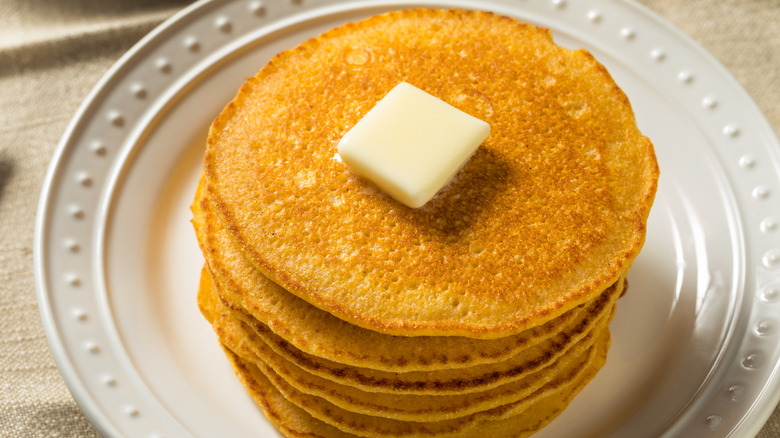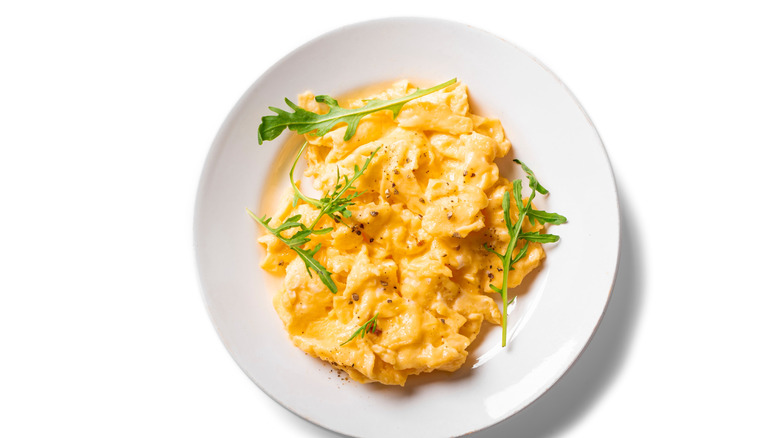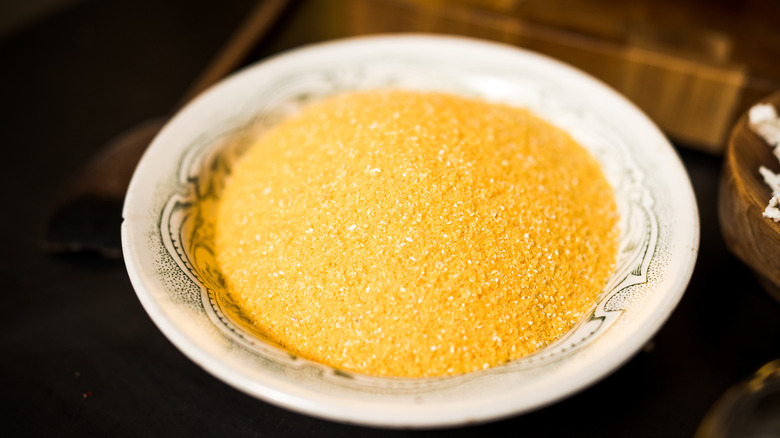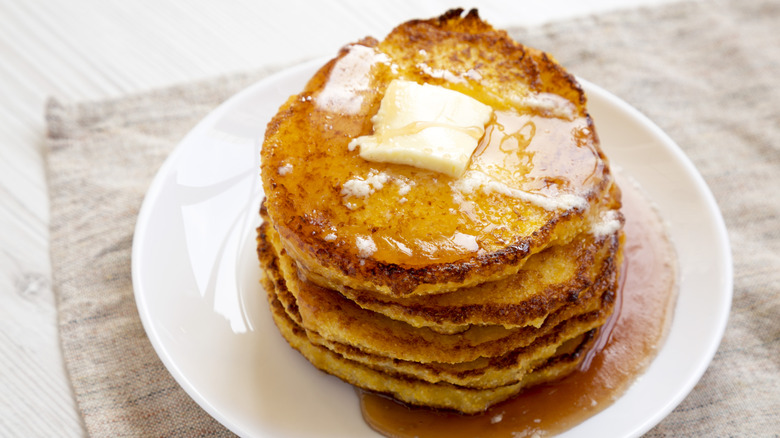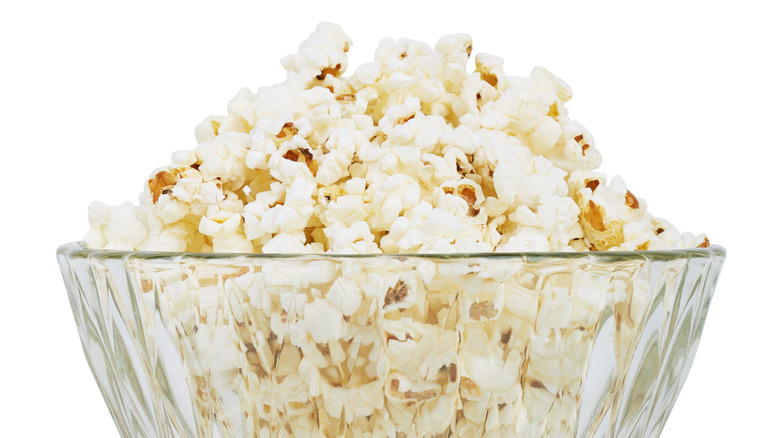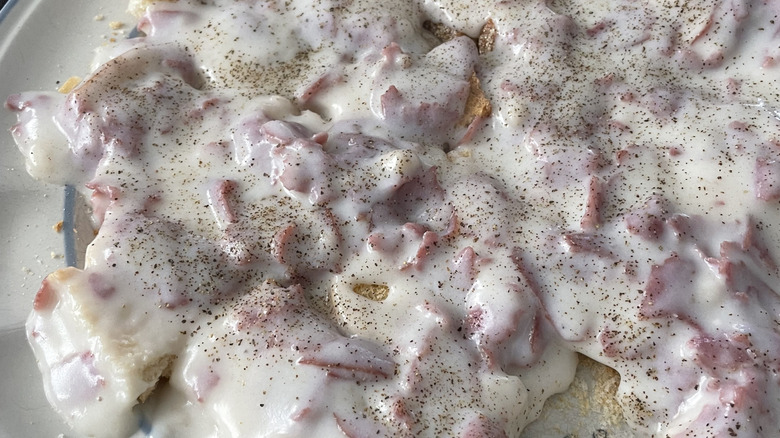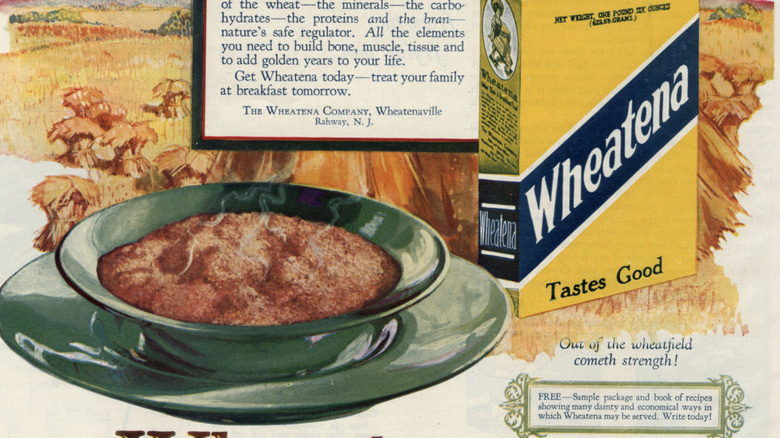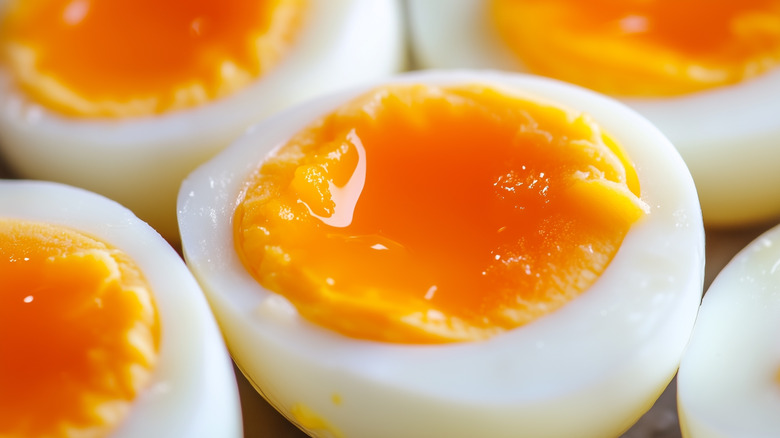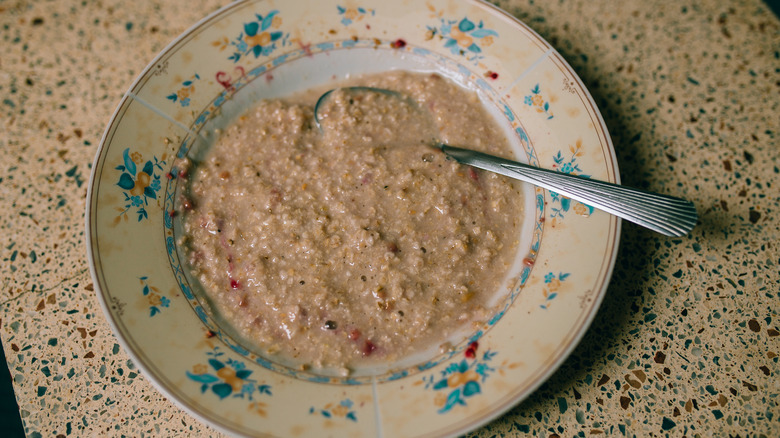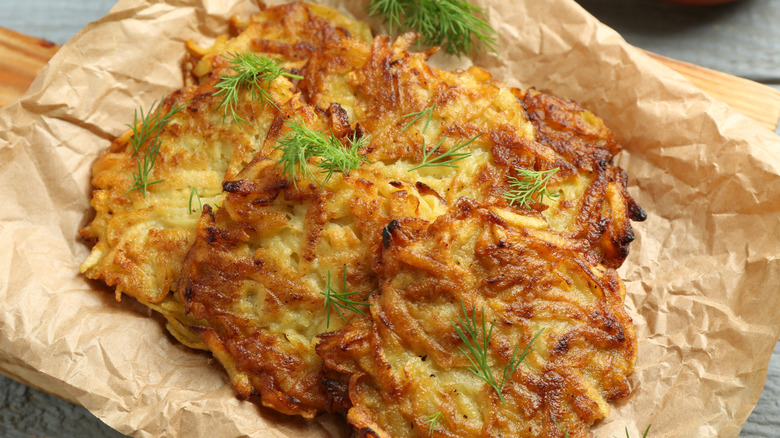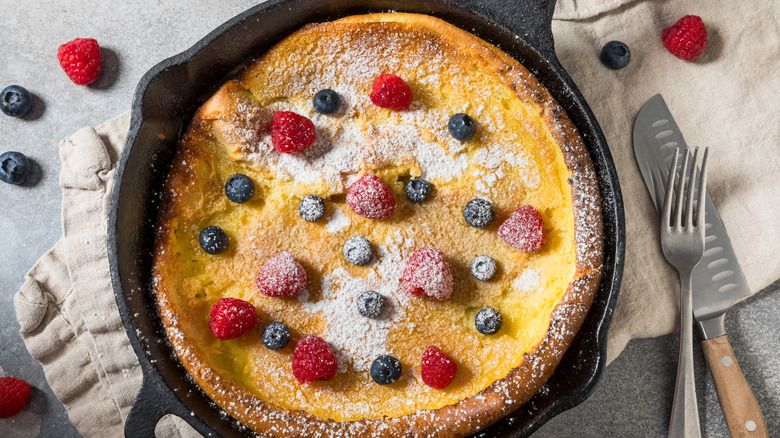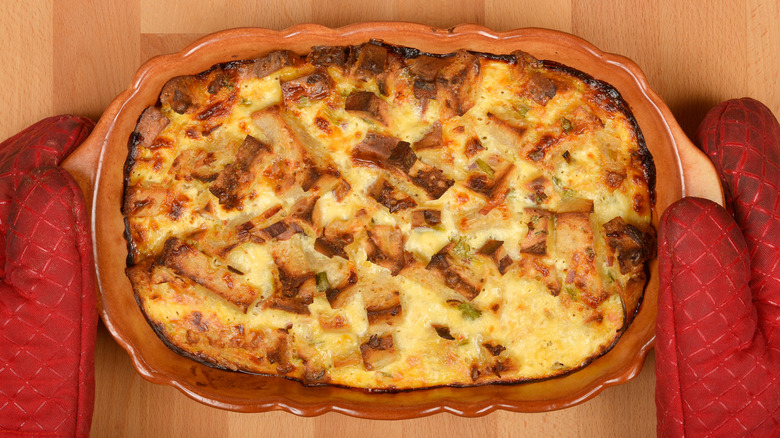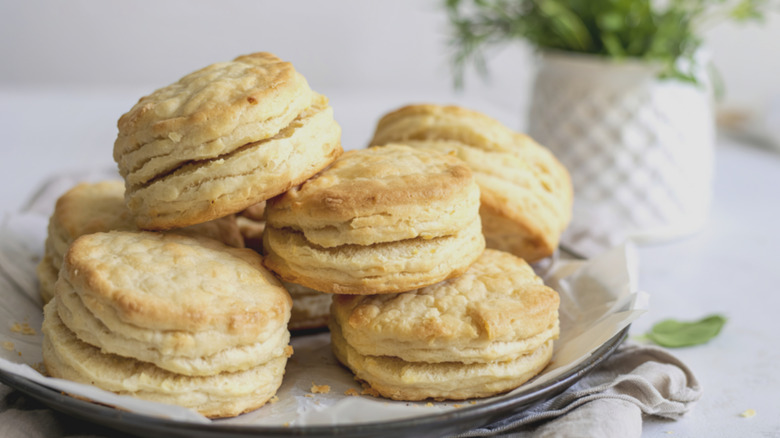Vintage Breakfast Food No One Eats Anymore
In today's rushed world, there's hardly any time to sit down and eat a well-balanced breakfast. Between preparing for work and getting your kids up and ready for school, the idea of enjoying a plate of homemade food every morning sounds like an idealistic (and unrealistic) dream. Today, we're more likely to just grab a cereal bar — or a toasted bagel, if we're lucky — on our way out the door than we are to sit down and dig into a pile of hot pancakes or crispy bacon.
Back in the day, however, people devoted more time and effort to the first meal of the day. Delicious comfort foods such as soft-boiled eggs and toast, and thick porridge were a more common occurrence, with leftovers from the day also occasionally worked into breakfast to save both time and money. Some of these vintage breakfast foods have roots in European culture and were brought to the United States by immigrants.
Over time, many of the dishes changed to reflect available ingredients before disappearing from menus. Meanwhile, other old-fashioned breakfast items evolved from Native American recipes, with some developed out of necessity during wartime and the Great Depression due to reduced food supplies and lack of finances. Here are some of the many tasty breakfast foods to fall out of favor over the years — and potentially even deserve a comeback at your kitchen table.
Pig brains and scrambled eggs
While this may sound unappetizing and unheard of to us today, at one point in time, sautéed pig brains with scrambled eggs was a common breakfast dish. Also called "offal," pig brains could be bought either fresh from your local butcher or in cans. The brains were typically scrambled with eggs to create a breakfast dish that was a staple in the American South.
Eating pig brains was a common occurrence during the Depression, when people used all parts of the hog. Dishes using pig brains became especially common during World War II, when meat was in short supply. The meal was considered economical because no part of the animal was going to waste, and the protein-rich breakfast could keep people satiated for several hours. The texture of the brains is said to be soft and fatty, similar to tofu, and blends well with the scrambled eggs.
If you're brave enough to bring this once-popular breakfast dish back into your kitchen, you may be able to find a can of pig brains on the shelf of a specialty store or even on Amazon. Fresh brains will require a vinegar and water bath, along with membrane removal. Scramble eggs along with the brains, adding salt, pepper, and seasonings (perhaps something strong enough to mask the taste of the brains) before serving.
Fried cornmeal mush
Fried cornmeal mush may not sound very appealing, but when prepared correctly, it can be an almost crave-worthy breakfast. Cornmeal mush is a simple Southern dish consisting of cornmeal and either water or milk, depending on the type of consistency you prefer. Mush is similar to the more popular dish grits. When prepared on a stovetop as a hot cereal, both cornmeal mush and grits become smooth and creamy. However, mush is typically sweetened up with the likes of maple syrup or sugar rather than seasoned with salt.
Cornmeal mush dates back to the Indigenous people of Mesoamerica, when cornmeal was referred to as "maize." Ground corn was brought to Europe in the 16th century, where it soon soared in popularity. Mush was often eaten as a breakfast food during the Great Depression because it was simple to prepare, economical, and plentiful. If you want to make this blast from the past, be sure to use mush that has been chilled in your refrigerator, or it'll be too soft. Fry the mush until it's golden brown and drizzle with maple syrup before serving.
Johnnycakes
Johnnycakes are an old-school breakfast item that you may remember your grandma making for you back in the day. These sweet, fluffy rounds of goodness are similar to pancakes, but are made with a combination of flour and cornmeal, or simply cornmeal.
Also known as hoecakes, johnnycakes have Native American roots that date back to the 1600s. Once a staple in New England cuisine, johnnycakes were also popular throughout the Caribbean and Newfoundland, where each locale put their own special twist on the dish. Later, johnnycakes were commonly made for breakfast by pioneers on the Oregon Trail, and were often served with bacon.
They're a simple yet delicious breakfast treat even today, especially when slathered with rich butter and sweet maple syrup. You can surprise your family with a stack of steaming hot johnnycakes by combining all-purpose flour, yellow cornmeal, buttermilk, and a few other staple ingredients to make a batter. For the best, most authentic flavor, fry the johnnycakes in pork fat and butter in a cast-iron pan.
Popcorn cereal
Yes, popcorn is a fun and delicious nighttime snack while watching a movie, but have you ever thought of saving your leftovers for breakfast the next day? During the colonial era, people ate popcorn with milk for breakfast, similar to the way we eat cereal today. Ella Kellogg, an American dietitian whose husband founded Kellogg's, enjoyed popcorn with milk or cream several years before cornflakes were even invented (via Popcorn.org). Native Americans also made a hot cereal by pounding their popcorn into a powder and blending it with water and maple syrup.
During the Great Depression, popcorn soared in popularity as it was both easily accessible and affordable. While today it's more commonly consumed as a snack and not as a cereal, that shouldn't stop you from trying it. Simply place unbuttered and unsalted popcorn in a bowl, and cover it with your favorite type of milk, including the non-dairy versions. This is where you can get creative, topping the old-fashioned cereal with any ingredients you'd like, including almonds, pine nuts, cashews, or pecan pieces for extra protein, or raisins and dates for a nutritious pop of sweetness.
Creamed chipped beef on toast
Creamed chipped beef on toast is a very versatile dish, in that it can be served as either a breakfast or dinner. You can even combine the two and serve last night's leftover creamed chipped beef over toast in the morning, and start your day with a hearty and filling meal. A simple combination of dried beef cut into strips, a basic white gravy, and toast, this dish is said to have originated in the United States military in the early 20th century. Dubbed "SOS" for "Same Old Slop" and another, non-PG-rated nickname, the recipe included anything from ground beef to sausage, depending on what was available at the time (via HistoryNet).
During World War II and throughout the next several wars, the U.S. Air Force began serving SOS, too. Prepare this vintage dish at home by making your favorite flour and milk-based white gravy recipe or using a jarred version if you're pressed for time. Add strips of packaged dried beef to the gravy, and pour the mixture over slices of toast made with white bread.
Wheatena
Before the popular packaged breakfast cereals that we have today, there was Wheatena. Described as a toasted wheat product that is prepared hot, Wheatena originated in a small New York City bakery on Mulberry Street in 1879. Unlike other retailers at the time, which typically scooped cereal out of barrels, the bakery started roasting whole wheat before grinding it and selling it in boxes. By the 1920s, Wheatena was advertised as a delicious cereal that appealed to children.
The 100% natural cereal is high in protein, whole grains, and fiber. In addition to being hearty and filling, Wheatena is also cholesterol-free, calcium-fortified, and naturally low in fat, sugar, and salt. While you can still purchase it and enjoy it as a hot cereal, the vintage wheat product also makes a creative muffin, bread, and stuffing ingredient, among other recipes. If you're trying to add more fiber into your diet, add Wheatena into your favorite chocolate chip, coconut, and peanut butter cookie dough.
Soft-boiled eggs
Plenty of people have hard-boiled eggs for breakfast, and even lunch and dinner, but soft-boiled eggs are much less common today than they were in decades past. Unlike their hard-boiled counterparts, soft-boiled eggs feature cooked whites with soft, runny yellow yolks that are ideal for dipping toast. The eggs were traditionally perched atop specialty ceramic egg cups in their shells. The tops were sliced off, revealing the ooey-gooey yolks inside.
With the invention of pottery, boiling became a popular way to prepare eggs. These perfectly dippable eggs were popular in Ancient Rome, and then gained popularity again in medieval France. During those days, the runny eggs were beloved for their digestibility and were considered a delicacy. To treat your family to perfect soft-boiled eggs today, boil them in a pot of water for four to six minutes, depending on how runny you like the yolks. Place the boiled eggs in egg cups and serve them with salt, pepper, and toast cut into strips for dipping.
Porridge
Traditional porridge used to be a staple breakfast food in multiple regions of the world in decades past. Porridge originated during the Paleolithic era, and, unlike oatmeal, can be made with any type of grain, including oats, wheat, barley, and rice. These grains are cooked in a liquid and then eaten either hot or cold. The warm and creamy cereal was also a typical breakfast dish in Ancient Rome, as well as during the Middle Ages, especially for the lower classes.
Classic English porridge typically calls for rolled oats to create the perfect texture and consistency. You can cook it with either water or milk, depending on how rich you want the hot cereal to be. As it cooks, the oatmeal will transform from a soupy mixture to a pot of thick, creamy cereal. Once the oats absorb all of the liquid and your porridge thickens to that consistency, you can sweeten it with sugar, honey, or maple syrup if you desire.
Potato pancakes
There is no better way to use up leftover mashed potatoes than to transform them into a perfectly crispy and salty breakfast food. Classic potato pancakes are as simple to prepare as they are delicious to eat, and can be served in a variety of ways, such as with fried or scrambled eggs or topped with applesauce and sour cream.
Since potatoes are typically cheap and abundant in Europe, and grow in harsh weather conditions, potato cakes are found in many different European cuisines under various names. For example, in Germany, they're referred to as kartoffelpuffer or reibekuchen, in Slovakia and Czechia, they're called bramborák, and in Belarus, the pancakes are called draniki. Latkes, a traditional Jewish dish, are also a kind of potato pancake.
While they aren't as common a breakfast dish as they once were, potato pancakes are still worth trying for your morning meal. If you want to try making vintage potato pancakes using mashed potatoes, start by mixing them with eggs, flour, salt, pepper, garlic, and any other seasoning you'd like in a bowl. Heat oil or butter in a skillet, and fry the pancakes so that they're golden brown on both sides.
Dutch baby pancakes
When topped with fresh fruit and powdered sugar, Dutch baby pancakes look as cute as they sound. This sweet breakfast food has the delicate texture of a crepe and is made with an eggy batter similar to a popover or a Yorkshire pudding. Dutch babies puff up considerably during the cooking process as the batter rises, resembling a soft pillow, but then collapse quickly when removed from the oven. The end result is a light and airy pancake that is traditionally topped with sweet ingredients such as fresh fruit, syrup, and whipped cream if you're feeling decadent.
Dutch babies originated in a Seattle diner known as Manca's Cafe decades ago, with the cafe filing to trademark the term in 1942. Although they aren't a particularly popular breakfast item anymore, Dutch babies still make a sweet treat any time of the day if you can find them. To make these delicious pancakes in your own kitchen, make a batter using eggs, flour, milk, sugar, salt, and vanilla extract. Pour the batter into a greased oven-safe skillet and bake until the pancake's edges are brown. Top with your favorite ingredients — such as butter, lemon zest, maple syrup, and berries — and cut the pancake into pie-shaped pieces.
Breakfast strata
On the more savory side of morning dishes, vintage breakfast strata is a tasty casserole made of eggs, bread, and a combination of meat and veggies, such as bacon and sautéed spinach. You can also use sausage, or make a completely meatless version if you so desire. The addition of bread gives the casserole a soft, spongy texture, and is a good excuse for using up an almost-stale loaf.
Strata, which is essentially a savory bread pudding, is said to have roots in the early 20th century, with one of its first appearances being the 1902 cookbook "Handbook of Household Science" by Juniata L. Shepperd. The earliest version didn't contain eggs, but it had a similar consistency. Going even further back, egg casseroles also have roots in the region of Pomerania in northern Germany. The German dish contained eggs, breadcrumbs, a mixture of vegetables and herbs, and was either baked or fried.
To make this time-tested breakfast dish, layer bacon, cubes of bread, cheese, and a few other ingredients in a baking dish. Pour a mixture of whisked eggs, milk, and your chosen seasonings over the top, and bake the strata until it's golden brown around the edges and puffy in the center.
Biscuits and red-eye gravy
Fluffy, tender buttermilk biscuits topped with savory red-eye gravy is a vintage Southern dish that definitely deserves a comeback. Although this specific type of gravy — which is made with coffee rather than a milk base – isn't as popular throughout the rest of the country today, it makes a delicious addition to breakfast and brunch tables.
Also known as red ham or poor man's gravy, this biscuit topping has a rich, bold flavor that is traditionally enhanced with country ham drippings. Honey, brown sugar, or molasses add a surprising touch of sweetness to the gravy that complements the flaky biscuits well. Although the origin of the gravy's distinctive name is up for debate, one theory says that it began when President Andrew Jackson requested a country ham with gravy as red as his cook's bloodshot eyes.
To make this classic and hearty Southern breakfast, start by cooking some ham slices in a skillet and removing the meat when it's done. Add butter, water, and strong black coffee to the hot pan and stir everything together with the meat drippings. Allow the mixture to simmer for a few minutes, and add any sweetener that you'd like. Pour the hot gravy over a plate of homemade biscuits and the ham, and you've got a tasty, nostalgic breakfast.
